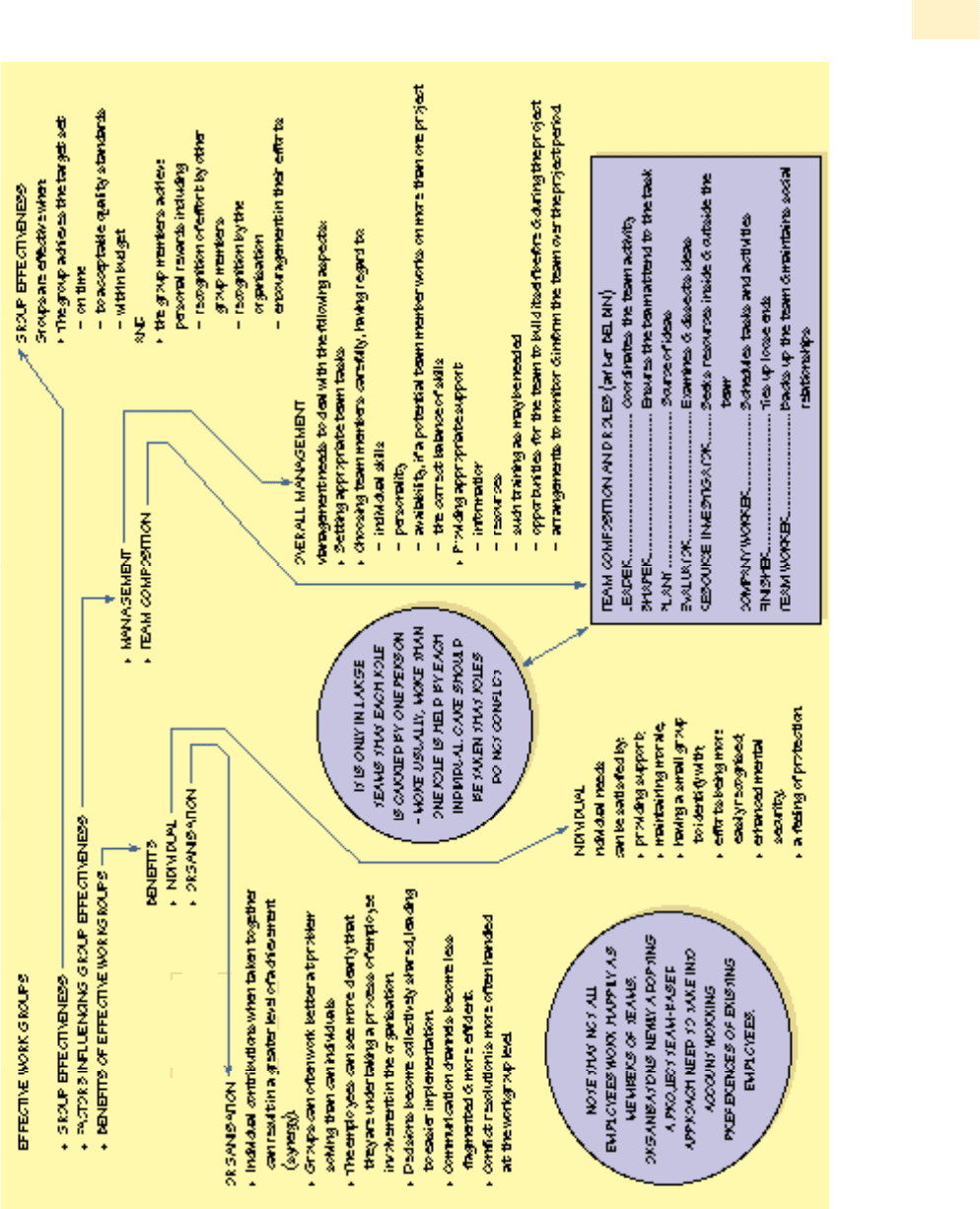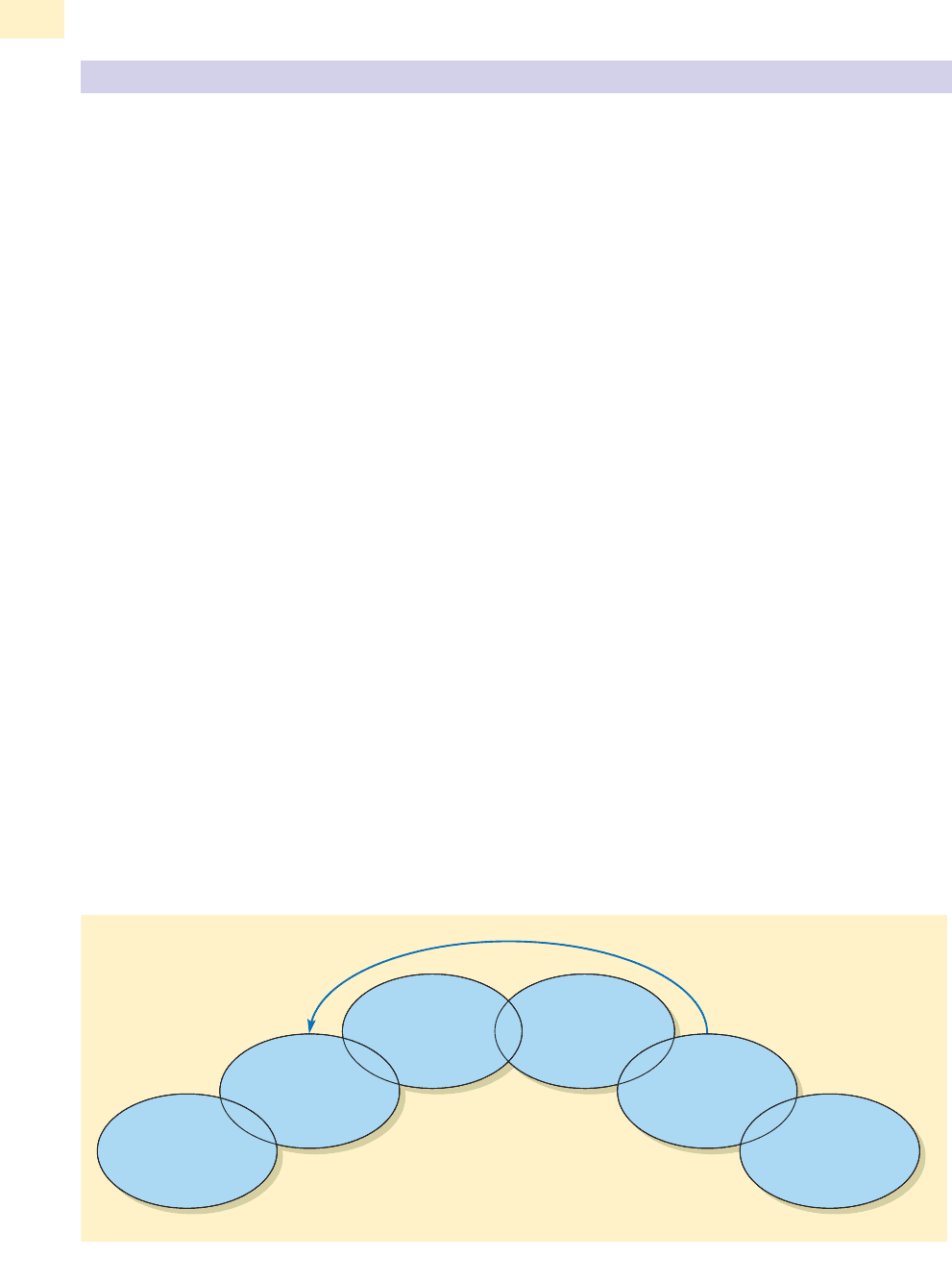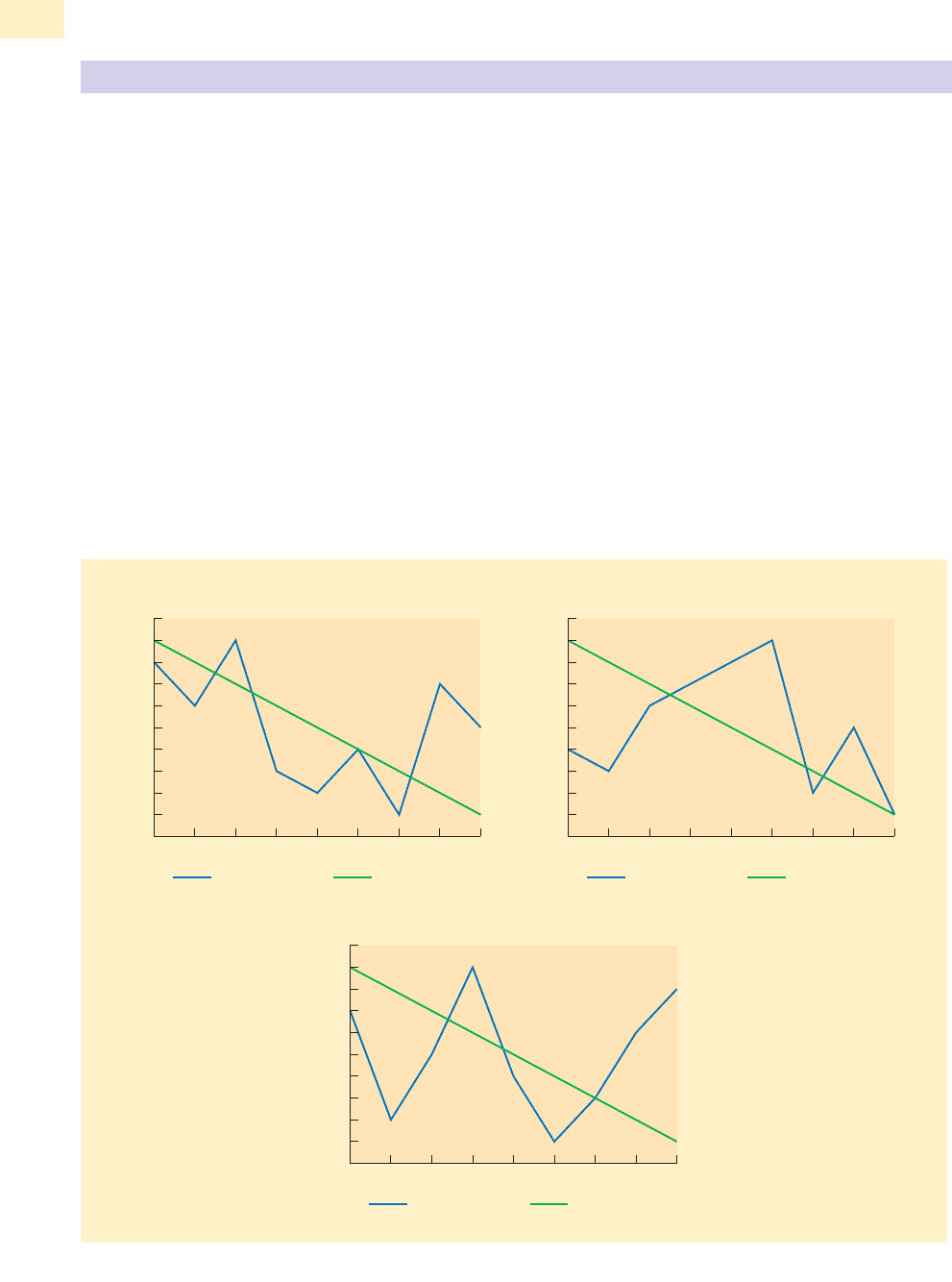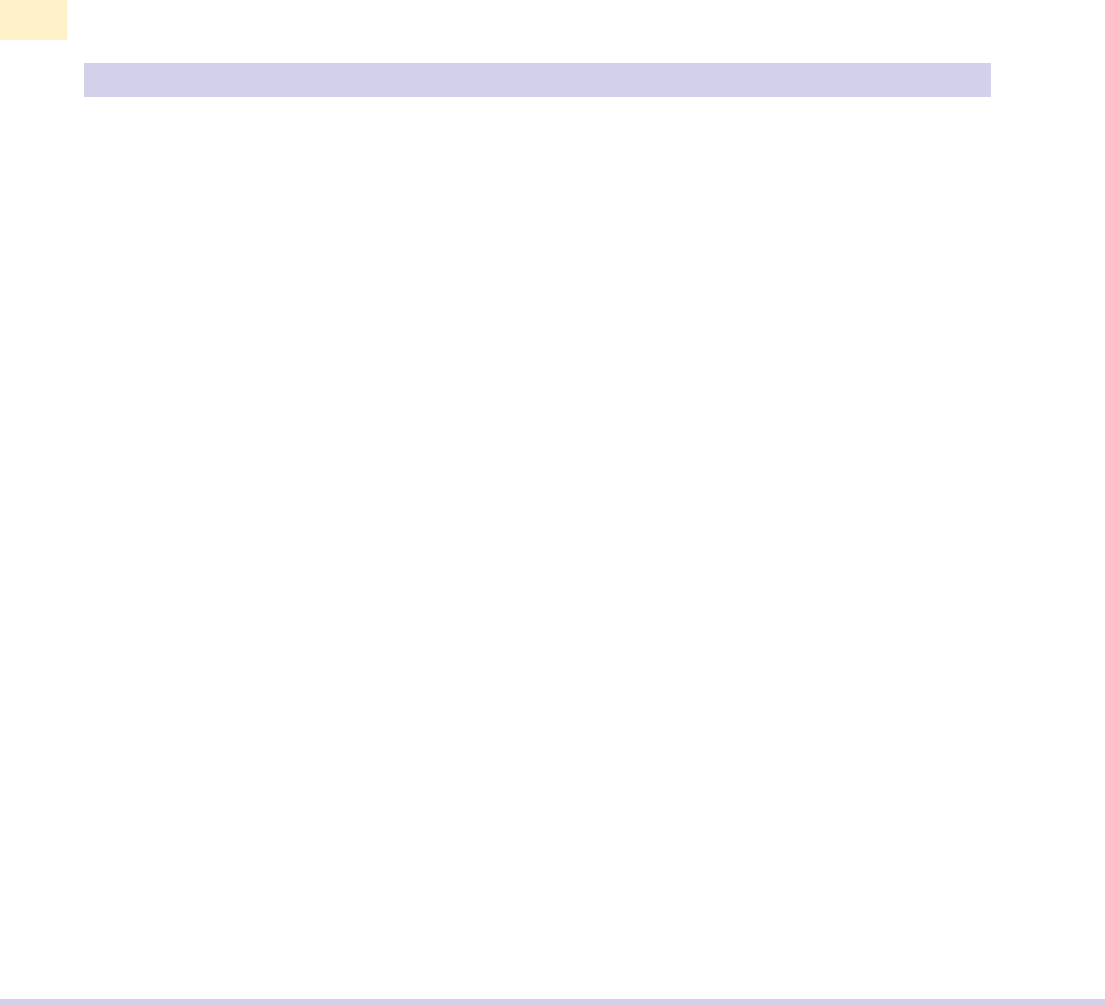Mullins L.J. Management and organisational behaviour, Seventh edition
Подождите немного. Документ загружается.


role of the group is to establish whether members conceal too much, or too little,
about themselves from other members.
■ The blind area includes mannerisms, gestures, and tone of voice, and represents
behaviour of the impact of which on others the individual is unaware. This is some-
times referred to as the ‘bad breath’ area.
Members must establish an atmosphere of openness and trust in order that hidden and
blind behaviours are reduced and the public behaviour enhanced.
Reactions to the value and effectiveness of T-group training are very mixed. The experi-
ence can be very disturbing and unpleasant, at least for some members. For example,
participants have described it as ‘a bloodbath and a psychological nudist colony in
which people are stripped bare to their attitudes’.
48
Participants are required to lay bare
their inner emotions and may feel an invasion of their privacy. The unstructured situa-
tion may permit trainers to impose their own perceptions and social viewpoints on
members of the group.
49
T-group training is difficult to evaluate objectively and there is still a main problem
of the extent to which training is transferred ‘back home’ to practical work situations.
However, a number of studies do suggest that participation as a member of a T-group
does increase interpersonal skills, induce change, and lead to open communications
and more flexible behaviour. T-groups probably do result in a change of behaviour but
it is not always clear whether such change is positive or related to improved organisa-
tional performance.
50
T-groups now take a number of different forms. Some place emphasis on the under-
standing of group processes, others place more emphasis on the development of the
individual’s self-awareness and feelings towards the behaviour of other people. They
are now used frequently as a means of attempting to improve managerial development
and organisational performance. The Blake and Mouton managerial grid seminars, dis-
cussed in Chapter 7, can be seen as an applied, and refined, form of T-group. A number
of different training packages have been designed, often under the broad heading of
interpersonal skills, which are less confrontational and less disturbing for participants.
The training often involves an analysis of group members’ relationships with one
another and the resolution of conflict.
51
Whatever the debate about a comparison between individual and group or team per-
formance, effective teamworking is of increasing importance in modern organisations.
This demands that the manager must be aware of, and pay attention to, a number of
interrelated factors, including:
■ clarification of objectives and available resources;
■ organisational processes and the clarification of roles;
■ empowerment, decision-making and channels of communication;
■ patterns of interaction, and attention to both task and maintenance functions;
■ social processes and the informal organisation;
■ management systems and style of leadership;
■ training and development.
The effectiveness of the team will also be influenced by the tasks to be undertaken, the
nature of technology and the organisational environment. Ultimately, however, the
performance of the team will be determined very largely by the characteristics of its
members. The nature of group personality means that what works well for one team
may not work well for an apparently similar team in the organisation.
CHAPTER 14 WORKING IN GROUPS AND TEAMS
575
Value and
effectiveness
of T-Groups
EFFECTIVE TEAMWORKING

As Wilson, points out, for example, although teamworking, like most management
ideas, is very simple, nevertheless this simplicity conceals a great challenge.
The principles of teamworking may be easily understood, but the task of installing it can be quite
daunting. Introducing teamworking is not a straightforward grafting job, the simple matter of
adding a new idea to those already in place. It is about making a fundamental change in the way
people work. Every teamworking application is different. Each organisation, department and
individual group is faced with unique problems and in some situations it is more about getting
rid of old ways of doing things than injecting new ones.
52
A ‘summary outline’ of effective work groups is presented in Figure 14.10.
Continuous process of improvement and innovation
The requirement for continual development and improvement is a necessary part of
effective teamwork. However as Riches, for example, points out: ‘Understandably, teams
are pre-occupied with getting the job done. Few teams regularly take time out to reflect
on how the team itself is working and what it needs to do to improve the way its
modus operandi. Even fewer set measurable objectives for team functioning and/or get
feedback from internal and external customers about the team’s effectiveness.’
54
The ACAS advisory booklet concludes that although self-regulation is necessary if
the potential of teamworking is to be realised, teams will always need some degree of
management direction. The task of management is to oversee the development of
teams and provide the necessary support and training. Even when in place, teams will
need constant monitoring and development. Teamworking is not a finite project but a
process of continuous improvement and innovation.
The introduction of team working is a major step for an organisation to take. It is important that
management, trade unions and employees ensure they know how teamworking will contribute to
their business strategy and that it is likely to involve a long-term transformation … The early chal-
lenge and excitement of establishing teams may fade and it is easy for organisations to accept a
level of performance which is short of optimum … In order to achieve high performance, teams
require regular changes and challenges. These may include: changes to team personnel; new
tasks; re-examining the contribution the team makes to the overall business aims; and ensuring
that the team has regular dealings with other teams.
55
576
PART 5 GROUPS AND TEAMWORK
Ten ways to motivate your team
53
1Be clear about your own goals 6 Get to know individuals
2 Inform everyone of theirs 7 Incentivise everyone
3 Give the right training 8 Be tough when necessary
4Coach and encourage 9 Give people space to grow
5Listen to members 10 Let them get on with it

CHAPTER 14 WORKING IN GROUPS AND TEAMS
577
Figure 14.10 Summary outline of effective work groups
(Reproduced with permission of Training Learning Consultancy Ltd., Bristol.)

■
Organisational performance and the satisfaction derived by individuals are influ-
enced by the interactions among members of the group. Members of a group must work
well together as a team and there must be a spirit of unity and co-operation. Belbin sug-
gests key contributions or team-roles for successful groups. The level of interaction is
influenced by the channels of communication. There are five main types of communica-
tion networks – wheel, circle, all-channel, Y and chains. Despite the artificiality, they
provide a reasonable representation of situations that might apply in large organisations.
■ In order to understand and to influence the functioning and operation of a group,
it is necessary to study the behaviour of individual members. Two main methods are
(i) sociometry, and (ii) interaction analysis. Sociometry is usually based on ‘buddy
rating’ or ‘peer rating’. It is a method of indicating feelings of acceptance and/or rejec-
tion among members of a group. A sociogram gives a diagrammatical illustration of the
pattern of interpersonal relationships derived from sociometry.
■ Interaction analysis is based on the assumption that the behaviour of individuals
may be analysed from the viewpoint of its function or process. Two essential functions
necessary for the success and continuity of a group are: (i) task-oriented behaviour; and
(ii) maintenance-oriented behaviour. In addition, members may display self-oriented
behaviour. Several frameworks have been designed for observers to categorise patterns
of verbal and non-verbal behaviour of members. It is important, however, that the
frameworks do not become too complex.
578
PART 5 GROUPS AND TEAMWORK
CRITICAL REFLECTIONS
‘I found all this discussion about group membership and building successful teams very interest-
ing and enlightening. It certainly makes good sense to me.’
‘Umm, I’m not so sure. It sounds fine in the classroom but I wonder how it works in practice
for example with managing workers on a production assembly line, in a gay pub, or profession-
als such as doctors or lawyers?’
What are your own views?
Well-constructed and well-balanced teams have a good chance of succeeding in the modern
world. But success is not ensured, however well the team functions. A common problem lies with
the environment of the team. The team may be mature but the organization may not be.
Hierarchies run organizations. They tolerate teams butare loath to see teams as alternatives to
hierarchical decision-making.
Belbin, R. M. Beyond the Team, Butterworth-Heinemann (2000), p. 68.
How would you attempt to ensure the success of teams within a hierarchical organisa-
tion structure?
‘Individuals will complete a task more efficiently and effectively than a group. And training in
group dynamics, whilst interesting, has no practical value as a means of increasing the standard
of group performance.’
Debate.
SYNOPSIS

■ Groups and teams are an essential feature in the life of the work organisation but it
is difficult to draw any firm comparison with individual performance. Group decision-
making would appear to offer a number of advantages but can be adversely affected by
the ‘risky-shift’ phenomenon and by ‘groupthink’. There also appears to be some
doubt about the effectiveness of brainstorming over an individual working under the
same conditions. Interest in the study of groups and teams has lead to the develop-
ment of training methods aimed at improving social interaction skills and self-insight.
■ Viewing the effectiveness of teamworking must take into account a variety of inter-
related factors, especially the characteristics and behaviour of their members. Building
successful teams also requires effective leadership with an emphasis on trust, clear
communications, full participation and self-management. Although self-regulation is
necessary if the potential of teamworking is to be realised, teams will always need some
degree of management direction. The task of management is to oversee the develop-
ment of teams and provide the necessary support and training. The requirement for
continual development and improvement is a necessary part of effective teamwork.
CHAPTER 14 WORKING IN GROUPS AND TEAMS
579
MANAGEMENT IN ACTION 14.1
Profiling of managers for leadership development in a cross-
section of South African organisations
THE SITUATION
With the acceleration of ‘transformation’ from white manager
domination in South Africa to a more legally equitable
56
distri-
bution of management and leadership in both the private and
public sector, it has become increasingly important to (a)
develop both the managerial and leadership skills of aspiring
black leaders and (b) find more objective, user friendly and
efficient ways of profiling management and leadership behav-
iour, thereby providing a means of raising self-awareness and
monitoring the leadership and management profiles of an
organization. There must be few countries in the world where
there is a greater need for assessing or profiling managers in
a helpful and constructive way so as to motivate corporate
and individual management development. And there must be
few countries in the world where there is a greater need to
bridge the gap between ‘ideal’ management requirements
and the large number of new inexperienced managers in both
the public and private sectors.
I use the terms ‘management and leadership’ here in the
sense of an equal partnership between management and
leadership, rather than two mutually exclusive approaches to
getting the work done with and through others. The
Leadership Development Project, outlined later in this paper,
places equal stress on the need for sound management
thinking and the need for sound leadership interaction and
relationships in the workplace. [For the sake of convenience I
will use the word ‘management’ from here onwards to cap-
ture the notion of an equal partnership between management
and leadership behaviour in the workplace.]
The objectives of this paper are:
(i) to present and explore a practical means of management
profiling with the aid of the Belbin programme, and illus-
trate how it is used in a Leadership Development Project
run in a cross-section of South African organizations,
(ii) to draw attention to the gaps between actual and ‘ideal’
profiles for managers, mentors or technical specialists,
and the likely implications of these gaps for management
development, and
(iii) to suggest possible courses of action to deal with these
gaps.
When using the word ‘ideal’ profile or ‘ideal’ requirements one
is automatically tempted to fall into the trap of claiming to
have found this will-o’-the-wisp ‘ideal’ manager or ‘ideal’
mentor, or whatever profile one is examining. There are many
instruments and many approaches to this search for the
‘ideal’ manager or ‘ideal’ manager profile. The one proposed
here makes extensive use of the Belbin Team Role computer-
aided package
57
for identifying a job profile, since it produces
profiles which are consistent with profiles from the intuitive
rankings of managers from a wide range of organizations; it is
user friendly and lends itself well to providing a foundation to
motivate learning and development.
THE LEADERSHIP DEVELOPMENT PROJECT (LDP)
Briefly, the Leadership Development Project is a well-tested
project which has been running since 1984 and has been
employed in a wide range of public service and private sector

580
PART 5 GROUPS AND TEAMWORK
organizations. The aim of the project is to raise individual and
corporate management performance through a series of one-
day seminars run at two- to three-week intervals which (a)
provide practical thinking and interactive tools for participants
to use in the work situation, and (b) require them to apply these
tools in a series of on-the-job assignments between seminars.
It is referred to as a ‘project’ since there is a serious attempt to
move away from the ‘training course’ paradigm to an ‘organi-
zation development’ paradigm where the whole organizational
unit, top-down–bottom-up, is involved in finding better ways of
managing for the present and the future. For more detail on this
project, the reader is referred to a comprehensive text
58
which
covers the thinking and interactive tools, as well as a more
recent shorter text
59
on the subject. Approximately 800 man-
agers have been through the project in some form, but it is only
since 1994 that deliberate use has been made of the Belbin
instrument. Clearly, as one uses it more, its application and
interpretation become more refined and helpful to participants.
The following diagram, Figure 14.11, outlines the flow of
the LDP process from phase 1 to phase 6. The strong link
between phase 2 and phase 5 is important since the tools
and skills the participants acquire on the seminars at phase 4
are applied, at phase 5, to some of the real life issues identi-
fied at phase 2.
In order to provide time for participants to apply what they
have learned between seminars, seminars are run at two- to
three-week intervals, during which time participants or teams
of participants complete and submit formal reports on their
applications assignments.
The Belbin profiles have a particular role to play at phase 1
of the project, although together with other means of feed-
back throughout the seminars and the assignments, constant
reference is made to these profiles and their implications for
the participants at all phases of the project. The Belbin pro-
files, together with other means of feedback, form part of a
strong commitment to experiential learning
60
where feedback
plays an important role in opening up the ‘window’ to partici-
pants on how they are seen and how they see themselves.
THE BELBIN TEAM ROLE INSTRUMENT
For about ten years the author has been testing out different
approaches to using the Belbin Team Role (Interplace) pro-
gramme. One of its strongest appeals is that it is user friendly.
Once participants have an understanding of the following
terms, they can start relating their profiles to their own orien-
tation as managers and identify their own strengths and
limitations in tackling management work. Belbin’s nine team
roles
61
are summarized below in the form they are used on
the Leadership Development Project:
■ Plant (PL) – Someone who ‘plants’ creative and innovative
ideas. Imaginative. Unorthodox. Brings new ideas to diffi-
cult problems. Limitations: Tends to be caught up in
his/her ideas and does not communicate (listen and
receive) easily with others. Prone to come in with new
ideas when all seems settled.
■
Resource Investigator (RI) – Someone who keeps in
touch with resources/people outside his/her immediate
environment. Extrovert. Enthusiastic. Communicative.
Explores opportunities. Limitations: Tends to lose interest
once the initial ideas have been launched. Does not sus-
tain effort in the same directon and continues to seek
new ‘contacts’.
■ Co-ordinator (CO) – Someone who co-ordinates the con-
tributions of others. Mature. Confident and trusting. Good
chairman and facilitator. Clarifies goals and promotes par-
ticipative decision making. Limitations: Not necessarily the
most clever or creative member of a group. May have lim-
ited input to the team effort. Could run the risk of being
seen as indecisive or not initiating ideas or action.
■ Shaper (SH) – Someone who gets others to ‘shape up’
and get the job done. Dynamic, outgoing. Pushes and
pressurizes and is determined to get around obstacles.
Limitations: Prone to provocation and shortlived outbursts
in his/her need to get on with the job and produce results.
Tends to be predominantly task focused.
Management in Action 14.1 continued
3. Objectives for
change and
improvement
5. On-the-job
Assignments
to deal with
issues
6. Integration
into the life of the
organisation
2. Identification
of priority
issues
1. Appraisal of
management and
organisation
4. Attendance at
management and
leadership
seminars
Figure 14.11 Flow of the Leadership Development Project

CHAPTER 14 WORKING IN GROUPS AND TEAMS
581
■ Monitor Evaluator (ME) – Someone who monitors and
evaluates clearly and analytically. Clear and rational
thinker. Sober. Discerning. Considers all options.
Evaluates carefully and accurately in making decisions.
Limitations: Tends to focus too much on clarity and logic.
Too analytical at times and tends to lose others in his/her
search for logic, evidence and clarity. Could slow things
down with too much systematic thinking and analysis.
■ Teamworker (TW) – Someone who is sensitive towards
and concerned about others and how they feel. Social,
mild, perceptive and accommodating. Listens and builds
on others’ ideas. Smooths friction. Limitations: Tends to
be over accommodating and indecisive in crunch situa-
tions where a decision – particularly an unpopular one –
has to be made. Can become too people focused and
neglect the job at hand.
■ Implementer (IMP) – Someone who concentrates on
implementation of ideas and decisions. Disciplined.
Reliable and efficient in getting the job done. Turns ideas
into practical action. Limitations: Tends to get too quickly
into ‘how’ and once actively involved in the plan is slow to
respond to changes or new possibilities.
■ Completer-Finisher (CF) – Someone who wants to get
the job completely right and strives to finish perfectly and
on time. Searches out errors and mistakes. Painstaking
and conscientious. Limitations: Tends to worry too much
about accuracy and getting the job right. Reluctant to del-
egate for fear of errors creeping in.
■ Specialist (SP) – Someone who brings specialist knowl-
edge and expertise to the job or problem. Dedicated.
Single-minded. Focused on his/her subject. Provides skills
in rare supply. Limitations: Tends to contribute on a very
narrow front. Does not contribute across a wide range of
issues and problems. May miss the importance of other
disciplines and specialities.
In summary, each participant completes a questionnaire and is
also invited to find four observers who know the participant in
the work context and complete an observer questionnaire of
positive and negative terms in confidence and anonymously to
the participant. (The observer forms are returned to the facilita-
tor directly for analysis.) The information from the completed
questionnaires is fed into a computer program and the results
shared with the participants in confidence at the start: of the
Leadership Development seminars. A corporate picture of the
leadership team roles, together with the results from a 60-item
management performance questionnaire, is also shared anony-
mously with the top management team (who have also
completed the questionnaires). The purpose of presenting
these is twofold: (i) to raise awareness of the gaps between
actual profiles and reasonably well researched ‘ideal’ profiles,
and (ii) to provide a basis for identifying needs and promoting
learning and improvements in performance.
BELBIN PROFILES ON THE LEADERSHIP
DEVELOPMENT PROJECT
This is not the place to go into further details of the Belbin
instrument itself. The above section should provide sufficient
background on the Belbin programme and how it works. On
the Leadership Development Project the following takes place:
1
Participants are briefed on the project with particular empha-
sis on the Belbin questionnaires and how to use them.
2 Self-assessment questionnaires are completed and
returned to the facilitator with at least four observers ques-
tionnaires (anonymously and confidentially).
3The data from the questionnaires are fed into a computer
program and individual reports are printed.
4 In addition to the computer reports, ‘ideal’ profiles for a
manager, a mentor and a technical specialist are provided
and both individual and corporate profiles are compared
with these ‘ideal’ profiles with the aid of graphs showing
deviations from the ‘ideal’ profiles.
5 During the first seminar, participants spend about three to
four hours discussing and exploring their own profiles and
their computer-generated reports.
6 The gaps between their ‘ideal’ and ‘actual’ profiles are dis-
cussed in relation to what is offered on the seminars, and
the participants invited to plan what they would like to do:
a Accept their strengths and limitations and find ways of
accommodating their limitations by finding someone
else to fill in the gaps (e.g. a poor Shaper may look for
help when he or she has to discipline someone).
b Focus on practising the tools offered during the semi-
nars which will help them to bridge some of the gaps
through learning and development of new skills.
cGive more attention to their natural orientations and not
get too hung up about their limitations – build on their
strengths within the context of their present jobs.
d Find ways of restructuring or even changing their jobs so
that they can accommodate their limitations and make
better use of their strengths (e.g. a strong Specialist and
Monitor Evaluator may decide to move out of manage-
ment work into more technical troubleshooting work, or
perhaps restructure his/her present job to help accom-
modate natural strengths and limitations).
The Belbin team role framework relates very easily to some of
the thinking and interactive tools presented on the
Leadership Development Project. Participants are able to
examine the gaps in their own performance and, where appro-
priate, use the relevant tools to develop the skills which will
help them to bridge these gaps. For example, Co-ordinator
(CO) is clearly related to team building, and organizing for
action which are offered as tools on the seminars. Similarly,
Shaper (SH) is related to the telling, selling and consultation
modes of communication, setting clear objectives, identify-
ing priorities and evaluating performance.
Graphs of the Belbin profiles
The three graphs (Figure 14.12) show the relative fit of a cross
section of 446 managers attending the LDP, with the ‘deal’
profiles of manager, mentor and technical specialist.
Participants were from 14 different organizations (private
sector, public sector and local govenument) and made up of
40% White, and 60% Black (Coloured, African and Indian)
participants. 284 of the 446 were involved in either local gov-
ernment or the police services. The graphs tell the story of
the gap between the ideal and actual average self-perception
profiles for this group of 446 managers. These three profiles
were chosen since all managers, although their main role is to

582
PART 5 GROUPS AND TEAMWORK
manage, also play a partial mentor and technical specialist role.
Showing how managers compare with the mentor and techni-
cal specialist profiles provides a useful basis for comparison.
For the purposes of this paper, however, only the implications
of the manager profile will be discussed in any depth.
At the outset, it must be stressed that these graphs and
comments on them are not the direct product of the Belbin
computer printouts, but are drawn from the Belbin computer
software statistics. The intention is to draw clear visual distinc-
tions between ‘good’ and ‘poor’ management behaviours, and
to reach conclusions about improving management perform-
ance. It must also be stressed that Belbin’s emphasis has been
on producing well-balanced teams, which are considered to be
more effective than poorly balanced teams where there is not a
good mix of the various team roles. Effective and well-
balanced teams are, clearly, essential. We know, for example,
what happens when a group of Shapers (SH) get together and
try to reach consensus – they tend to fight and argue to estab-
lish who is ‘boss’ instead of concentrating on the problem or
task at hand. In this paper, the profiles focus more on manage-
ment behaviour and how to deal with management strengths
and limitations, rather than the dynamics of management
teams and how to form effective ones.
How are these graphs used on the LDP?
Similar graphs are used on the LDP and provide a fruitful
basis for discussion and learning. Individuals plot their own
individual profiles based on what is referred to in the Belbin
computer printouts as ‘assessment results in rank order’. This
shows their (i) self perception profiles, (ii) how each observer
ranks them on the 9 team role dimensions and (iii) their overall
profile which is a consolidation of self and observer assess-
ments. They then draw their own conclusions about the
discrepancies between these profiles, and explore why they
see themselves differently from others and why they don’t fit
the ideal profiles as well as they would like to fit them. To
stimulate further motivation, the average % fit for the group
as a whole is calculated, and a rough group profile is plotted,
so that each person can compare how well he/she shapes up
against the group as a whole.
10
9
8
7
6
5
4
3
2
1
0
(a) Manager profile
SH
CO IMP RI ME TW PL SP CF
45% fit
Actual profile
Ideal profile
10
9
8
7
6
5
4
3
2
1
0
(b) Mentor profile
TW
RI CO SP SH IMP ME CF PL
40% fit
Actual profile
Ideal profile
10
9
8
7
6
5
4
3
2
1
0
(c) Technical specialist profile
SP
ME CF IMP TW PL RI CO SH
30% fit
Actual profile
Ideal profile
Figure 14.12 Comparing ‘actual’ with ‘ideal’ profiles in a cross-section of 446 managers
Management in Action 14.1 continued

CHAPTER 14 WORKING IN GROUPS AND TEAMS
583
Matching the manager profile
Figure 14.12 (Management Profile) shows the comparison of
a large sample of 446 managers with the ideal manager pro-
file where there is a 45% fit for this group of 446 managers.
It is interesting to compare the overall average fit of 45%
with the 60% fit of a nine-person top executive team – which
was one of the 14 groups identified in the sample of 446 man-
agers. Is it safe to assume that this top team is better than the
overall average manager in this sample of 446? I suggest that it
is probably a safe assumption. It is also interesting that four
chief executive officers who completed Belbin ratings from this
particular sample of managers all scored 50% fit or above on
their self-assessments as compared with the average of 45%
fit for the group as a whole. There is some evidence, therefore,
that the better the % fit with the ‘ideal’ manager, the greater the
likelihood of occupying a more senior job.
However, this is a very general statement. One can have a
good overall fit as one finds in this sample of managers, but
still have some serious limitations on particular dimensions.
Even in this large sample of 446 managers, the manager pro-
file in Figure 14.12 illustrates a tendency towards too much
attention to detail (CF) and an orientation towards narrow
specialization (SP), which are less desirable tendencies in
management work. This profile also illustrates a general need
for more attention to looking outwards and keeping in touch
with events and circumstances in the environment, which is
characteristic of the RI.
One particular chief executive, when comparing his overall
profile (which included the ratings of at least four observers)
with the ideal profile for a manager (see Figure 14.13), matched
very well on coordinator (C0) and this was evident from his abil-
ity to listen and draw others in when tackling issues, and make
best use of their abilities. However, as can be seen from the
graph (Figure 14.13) he was well below on Shaper (SH) and
Resource Investigator (RI), and had a bit too much Monitor
Evaluator (ME) for the job of a chief executive officer. This
pointed to his need to: (i) push more for results (SH); (ii) focus
on what was happening in the broader market place (RI) –
making good contacts with important role players in the busi-
ness; and (iii) spend less time analysing problems (ME) and
focus more on broad strategic decisions. It is also interesting
that this particular executive rated himself at a 50% fit with the
ideal management profile based on his self-perception,
whereas comparing his overall profile (which included the rat-
ings of at least four observers) with the ideal manager profile,
he had a 30% fit. Clearly, he saw himself being more effective
as a chief executive than his observers saw him.
Do the Belbin profiles and the LDP make a real
difference back on the job?
This is always the million-dollar question to be answered in
this kind of work. Clearly, the Belbin profiles are only one
aspect of the LDP and provide some of the stimulus for learn-
ing and change. The other dimensions in the LDP play a
major role through the seminars and the application assign-
ments, where particular performance issues are addressed.
The final phase of the LDP strategy (phase 6, Figure 14.11)
provides for participants on the project to meet after the
formal seminars are over, and work out a plan for integrating
what they have learned into the life of the organization. This
often involves presentations to the top management team
who, in general, are very supportive if they have had sufficient
exposure to the LDP themselves.
Evaluation of the impact of the LDP takes place at three
levels. First, there is a final ‘test’ of the concepts and under-
standing of the tools and their applications. This, together
with the marks from the assignments, provides the final mark
for success on the LDP. Our experience has been that the
inclusion of a test of understanding and application adds
motivation and commitment to learning, and is accepted at all
levels of management if it is appropriately ‘sold’ as an aid to
learning and better performance. The average pass mark on
the last 10 projects is 67%. Second, participants rate their
perceived shift in ability on the course objectives from the
start to the finish of the course. The average at the start is
42% and, at the end, 82%, which shows a substantial per-
ceived increase in ability on the course objectives. Third,
wherever possible, the organization is invited to assess the
extent to which their initial project objectives were achieved
(see phase 3 of the project). Limited studies done so far show
that, on average, 80% of the participants and their colleagues
rate the LDP as having a high impact on the project objec-
tives. The ratings of high impact on particular project
objectives range from 50% to 95%, showing that the impact
of the LDP on the project objectives was higher for some
objectives than for other objectives.
CONCLUSIONS
The objectives of this paper were:
(i) to present and explore a practical means of management
profiling with the aid of the Belbin programme and illus-
trate how it is used in a Leadership Development Project
run in a cross-section of South African organizations,
(ii) to draw attention to the gaps between actual and ‘ideal’
profiles for managers, mentors or technical specialists,
and the likely implications of these gaps for management
development, and
(iii) to suggest possible courses of action to deal with these
gaps.
Figure 14.13 Profile for one chief executive

584
PART 5 GROUPS AND TEAMWORK
Use of Belbin profiles in the Leadership
Development Project
By comparing actual profiles based on the Belbin ‘team role’
dimensions with the ‘ideal’ profiles, participants on the
Leadership Development Project gain insight into themselves and
their organizations, and identify possible areas for change and
improvement. Particular reference is made to comparisons
between the actual and ideal profiles for management work, men-
toring work and technical specialist work. Although this group of
446 managers fits the manager profile (45%) substantially better
than the specialist profile (30%), there seems to be a tendency for
managers to continue to adhere to their specialist role, to give too
much attention to detail, and to give insufficient attention to look-
ing outwards so as to keep in touch with important events and
role players in the external environment. As managers and lead-
ers move into different roles, they can use these profiles to
identify and address these gaps in their own performance. The
Leadership Development Project helps to bridge some of these
gaps by providing relevant thinking and interactive tools which
participants practise and apply in assignments back on the job.
Implications of the gaps with mentor and technical
specialist profiles
When comparing managers’ actual profiles with other profiles
such as the mentor and technical specialist profiles, it is clear
that there are gaps which need to be filled – depending on
the extent to which the particular manager is required to be a
‘mentor’ or a ‘technical trouble shooter’ in his or her job.
Meeting the requirements of the technical specialist is prob-
ably a less important role than being an effective mentor,
since most managers are required to develop their staff and
release responsibility through appropriate empowerment and
delegation. Too much focus on implementation (IMP – details
of how to do the job properly) and having insufficient sensitivity
to others (relatively low on team worker – TW) are general areas
of concern in this sample of 446 managers, most of whom
have mentoring as well as management responsibilities.
Specific courses of action to deal with the gaps
While overall % fit provides a rough indication of how well
individuals fit the ideal profiles, each person examines partic-
ular gaps on particular dimensions, and explores how partic-
ular thinking and interactive tools provided on the seminars
can help him or her to change or improve. Gaps between
ideal and actual profiles can be addressed through formal
training such as that provided on the LDP seminars. But it is
stressed that most is achieved by applying what is learned
on the job itself through carefully designed assignments and
feedback. First-hand experience encourages real life experi-
ential learning, and the best seminars in the world are
unlikely to be a substitute for what we learn by doing it our-
selves in the ‘real world’ environment. It is also suggested
that not all of the gaps between what managers are and
what they would like to be can be or should be overcome
through training and attempts to change their own behaviour.
Restructuring the job, improving systems and proce-
dures, finding others to address these gaps are alterative
strategies. Trying to be all things to all people in all situations
is probably unrealistic. Changing job structures, providing
support systems or just getting help from others are worth-
while alternatives. There is also a risk of over-emphasizing
the correcting weaknesses and devoting insufficient energy
to developing strengths.
WHERE FROM HERE?
This paper has dealt with the corporate needs of 446 man-
agers in 14 organizations/groups rather than individual
needs arising from the LDP and the Belbin profiles. How indi-
vidual profiles, needs, assignments and learning are tackled
on the LDP has not been discussed in any depth. In-depth
examination and evaluation of the impact of the LDP with the
aid of the Belbin questionnaires and other instruments used
on the LDP would require separate research. However, this
paper has shown the likely benefits from this work and
avenues for further exploration.
H. J. Misselhorn
M.O.D. Consulting, South Africa
I am grateful to Hugo Misselhorn for providing this information, which is reprinted
with permission.
Management in Action 14.1 continued
